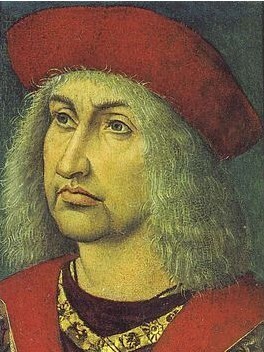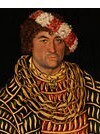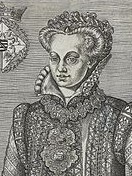Families Klein, Ree, de Breed en de Vries van Terschelling » Mauritz van Saksen (1521-1593)
Personal data Mauritz van Saksen
Source 1- He was born on March 21, 1521.
- He died on July 15, 1593, he was 72 years old.
- A child of Hendrik V. (de Vrome) van Saksen and Catharina van Mecklenburg
Household of Mauritz van Saksen
He is married to Agnes van Hessen.
They got married.
Child(ren):
- Albert van Saksen 1545-1546
Notes about Mauritz van Saksen
Maurice (21 March 1521 – 9 July 1553) was Duke (1541–47) and later Elector (1547–53) ofSaxony. His clever manipulation of alliances and disputes gained the Albertine branch of theWettin dynasty extensive lands and the electoral dignity.
1521–1541: Infancy and youth
Maurice was the fourth child but first son of the still-Catholic Duke Henry IV and the ProtestantCatherine of Mecklenburg-Schwerin.
In December 1532, Maurice, aged 11, came to live at the castle of his godfather Albert of Brandenburg, cardinal, archbishop of Magdeburg and archbishop of Mainz. For two years, he lived the contemplative life of a cardinal until his uncle, the Duke George, demanded his return to his homeland and began the training of the later Saxonian Duke and educated him as a catholic. After 1536 Maurice's father was converted to the Protestant faith, the entire Duchy followed him. Henry and Catherine again took the education of their son into their hands. When Maurice was 18 years old, he left his parents and moved to live with his older cousin John Frederick I, who resided in Torgau and was despised by Maurice; this led to a strong hatred between them both. With another cousin, however, the Landgrave Philip I of Hesse, whom he met in Dresden, Maurice struck up a lifelong friendship.
After Maurice came of age, in 1539, his parents began to look for a wife for him. The favorite was Philip's eldest daughter, Agnes. The marriage plans threatened to fail, however, because of the illegal double marriage of the Landgrave. Without the knowledge of his parents, Maurice remained committed to his engagement with Agnes. The wedding, particularly disapproved of by his mother, took place in Marburg on 9 January 1541. Letters from that time illustrate the strong mutual devotion of the couple. Together they had two children:
- Anna (b. Dresden, 23 December 1544 – d. Dresden, 18 December 1577), married on 24 August 1561 to Prince William I of Orange-Nassau. They divorced in 1574.
- Albert (b. Dresden, 28 November 1545 – d. Dresden, 12 April 1546).
[edit]1541–1548: The Wurzener Feud and the Schmalkaldic War
Main article: Schmalkaldic WarOn 18 August 1541 Duke Henry died, and Maurice, as the eldest son, succeeded him as Duke of Saxony and Head of the Albertine Line. He replaced most of his advisors, because they had been opposed to his marriage with Agnes from the very start. George von Carlowitz, one of the new confidants of the Duke, advised Maurice (in order to prevent a war with Emperor Charles V and his brother Ferdinand, at the same time King of the Romans and his neighbour as King of Bohemia) not to endanger the survival of the Protestant Movement.
Thus he participated in the emperor's army in the war against the forces of the Sultan Suleiman the Magnificent of the Ottoman Empire (1542), Duke William of Jülich-Cleves-Berg (1543), and King Francis I of France (1544). However, on the other hand, the Duke confiscated the properties of the Catholic Church in his lands. From the wealth of dissolved monasteries in his country Maurice founded the princes' schools (Fürstenschulen) of Schulpforta (100 places), Meissen (60 places) and Grimma (70 places). The legal basis for this was the "New National Order" (Neue Landesordnung) of 1543.
Later, Maurice refused to join the Protestant Schmalkaldic League, although the Landgrave Philip of Hesse, his friend and father-in-law, was its leader. The principal reason for his refusal to do so is generally regarded as his hate for his Ernestine cousin John Frederick I and the Imperialpromise of the Saxon electorship, then held by John Frederick. In the Holy Week of 1542, in the process of the Wurzener Feud (Wurzener Fehde) it nearly came to a fratricidal war, because John Frederick occupied the jointly administered "Wurzener Country". There had previously been a controversy between Maurice and John Frederick over the use of tax funds from this area. The intervention of the Landgrave Philip of Hesse and Martin Luther prevented the war.
Due to the energetic persistence of the Elector John Frederick in establishing the Protestant Faith, the Emperor Charles V, on 20 July 1546, imposed the Imperial Ban (Reichsacht) on him, with the agreement of the Catholic Imperial Estates, the enforcement of which was laid on Maurice after the Wurzener Feud. The emperor tried in this way to drive a still deeper wedge into the Protestant camp in order to prevent a further propagation of the Protestant Faith. In the case of a successful enforcement, Maurice hoped to be invested by the emperor with the Electorship. Maurice hesitated for a long time, since by this punitive action his father-in-law Philip of Hesse would have been affected also. But when the brother of the emperor, Ferdinand I, himself wanted to initiate a campaign against the Electorate of Saxony, he had to call it off, in order not to lose the initiative in his own lands to the Habsburgs.
Maurice returned to Charles's camp. After initial successes — he occupied the Electorate of Saxony nearly without a fight — Maurice with his army was driven back by the Schmalkaldic League and retreated towards Bohemia. In the crucial Battle of Mühlberg on the Elbe, the Emperor and his brother Ferdinand, as well as Maurice, were able to defeat the Schmalkaldic League by capturing Landgrave Philip and John Frederick. According to contemporary chronicles, all of this happened on the same day, 24 April 1547. In order to escape being beheaded, John Frederick ceded the Electorate and sizable lands to Maurice in the Surrender of Wittemberg. In a brief ceremony in the field camp after the battle on 4 June 1547 Duke Maurice of Saxony was raised to the dignified position of Elector of Saxony. The official appointment took place later, but at a high price: He had betrayed the Protestant Faith and had brought his father-in-law, Philip of Hesse, into a hopeless situation. Maurice assured him that he would not be imprisoned, if he would surrender to the emperor. However, Philip was taken prisoner and exiled, after he had fallen on his knees before Charles V.
[edit]1548–1553: The Diet of Augsburg and the Peace of Passau
Maurice, insulted after these incidents by his compatriots and called a "Judas", was also disappointed by the emperor's attitude (because now Charles V tried to reintroduce Catholicism into the Empire's Protestant territories and the continued imprisonment of his father-in-law, Landgrave Philip of Hesse, whose freedom Charles V had guaranteed), he hid his feelings from him up to the Diet of Augsburg on 25 February 1548, where the ceremony of the formal inauguration of Maurice as Elector of Saxony took place. Charles V hoped that, with Maurice's appointment as the Elector of Saxony, with the signing of the agreement known as the Augsburg Interim, and with his own assistance, they could put an end to the religious strife that was splitting his empire.
When commissioned to capture the rebellious Lutheran city of Magdeburg (1550), Maurice seized the opportunity to raise an army and signed anti-Habsburg compacts with France and Germany's Protestant princes.
In the Treaty of Chambord signed with the French King Henry II in January 1552 Maurice promised the King money and weapons to assist him in his campaign against Charles V. In return, Henry was able to take four Imperial cities (Metz, Toul, Verdun and Cambrai) as well as their bishoprics, although Maurice had no right to them.
In March 1552 the rebels overran the southern German states, including parts of Austria, forcing the Emperor to flee and release Philip of Hesse. While Henry advanced up to the Rhine and occupied the promised Imperial lands, the emperor surprised by the attack fled over the Alps to Villach in the Austrian Duchy of Carinthia. In view of this success, Maurice abandoned his alliance with Henry II and negotiated a treaty with Charles's brother King Ferdinand I, to which Charles willingly agreed. When the Peace of Passau, was signed in August 1552, the Lutheran position was provisionally guaranteed. As part of the Peace, his former opponents from the Schmalkaldic War, John Frederick I of Saxony and the Landgrave Philipp of Hesse were released. The war was terminated in 1556 by Ferdinand I; the Imperial cities remained in possession of the French.
When Maurice returned to Saxony after the Peace of Passau, he was no longer seen as a traitor; both Protestants and Catholics rendered him equal respect. In addition the emperor in correspondence to both parties exhorted them to maintain peace in his empire; shortly after, he campaigned against the Ottomans in Hungary. The Margrave Albert Alcibiades of Brandenburg-Kulmbach (who had rejected the Passau armistice) soon afterwards conquered the bishoprics of Würzburg and Bamberg — which had been under his control for eleven years previously, after their former owner, John Frederick had ceded them to him — as well as the Imperial city of Nuremberg. This was the beginning of the Second Margrave War, which only ended with the Peace of Augsburg of 1555.
In 1552 Maurice with the army of the Holy Roman Empire (11,000 men) marched into Hungary. The Ottomans besieged Eger, but the Black Death broke out in Hungary, and Maurice did not dare to move up his forces.[1]
[edit]Death
Albert Alcibiades was a former ally of Maurice, who had fought in the Schmalkaldic War on his side. But now Maurice, involved in an alliance of princes, with Ferdinand I amongst others, was compelled to fight against Albert Alicibiades. On 9 July 1553 the Battle of Sievershausen took place at Lehrte. Maurice won this battle, but was badly wounded in the stomach by a shot from the rear and succumbed two days later in the field camp at the age of 32. He was buried in Freiberg Cathedral. In 1853, 300 years after the battle, the place of his death was commemorated by a monument erected to his memory. The 7.5 ton heavy granite monument came from his native Saxony.
Because Maurice died without a surviving male heir, his brother Augustus succeeded him as Elector. In Dresden, shortly after the death of Maurice, he erected the Maurice Monument (Moritzmonument), the first historical monument to be erected in Saxony.
Timeline Mauritz van Saksen
 grandparents
grandparents
 parents
parents
 brothers/sisters
brothers/sisters
 children
children
Ancestors (and descendant) of Mauritz van Saksen
Mauritz van Saksen  | |||||||||||||||||||||||||||||||||||
Agnes van Hessen | |||||||||||||||||||||||||||||||||||
Sources
- Cardinaal Web Site, Nick Cardinaal, Moritz von Sachsen, January 14, 2014
Added by confirming a Smart Match
MyHeritage.com family tree Family site: Cardinaal Web Site Family tree: cardi221111
Historical events
Birthday March 21, 1521
- Graaf Karel II (Oostenrijks Huis) was from 1515 till 1555 sovereign of the Netherlands (also known as Graafschap Holland)
- In the year 1521: Source: Wikipedia
- January 28 » The Diet of Worms begins, lasting until May 25.
- April 7 » Ferdinand Magellan arrives at Cebu.
- April 27 » Battle of Mactan: Explorer Ferdinand Magellan is killed by natives in the Philippines led by chief Lapu-Lapu.
- April 29 » Swedish War of Liberation: Swedish troops defeat a Danish force in the Battle of Västerås.
- June 30 » Spanish forces defeat a combined French and Navarrese army at the Battle of Noáin during the Spanish conquest of Iberian Navarre.
- August 29 » The Ottoman Turks capture Nándorfehérvár (Belgrade).
Day of death July 15, 1593
- Stadhouder Prins Maurits (Huis van Oranje) was from 1585 till 1625 sovereign of the Netherlands (also known as Republiek der Zeven Verenigde Nederlanden)
- In the year 1593: Source: Wikipedia
- February 12 » Japanese invasion of Korea: Approximately 3,000 Joseon defenders led by general Kwon Yul successfully repel more than 30,000 Japanese forces in the Siege of Haengju.
- May 12 » London playwright Thomas Kyd is arrested and tortured by the Privy Council for libel.
- May 18 » Playwright Thomas Kyd's accusations of heresy lead to an arrest warrant for Christopher Marlowe.
- June 22 » Battle of Sisak: Allied Christian troops defeat the Ottomans.
- July 25 » Henry IV of France publicly converts from Protestantism to Roman Catholicism.
- August 27 » Pierre Barrière failed an attempt to assassinate Henry IV of France.
Same birth/death day
- 1474 » Angela Merici, Italian educator and saint († 1540)
- 1501 » Anne Brooke, Baroness Cobham, English noble († 1558)
- 1521 » Maurice, Elector of Saxony († 1553)
- 1527 » Hermann Finck, German composer and educator († 1558)
- 1555 » John Leveson, English politician († 1615)
- 1557 » Anne Howard, Countess of Arundel, English countess and poet († 1630)
- 1542 » Lisa del Giocondo, subject of Leonardo da Vinci's painting Mona Lisa (b. 1479)
- 1544 » René of Châlon (b. 1519)
- 1571 » Shimazu Takahisa, Japanese daimyō (b. 1514)
- 1609 » Annibale Carracci, Italian painter and illustrator (b. 1560)
- 1614 » Pierre de Bourdeille, seigneur de Brantôme, French soldier, historian, and author (b. 1540)
- 1655 » Girolamo Rainaldi, Italian architect (b. 1570)
About the surname Van Saksen
- View the information that Genealogie Online has about the surname Van Saksen.
- Check the information Open Archives has about Van Saksen.
- Check the Wie (onder)zoekt wie? register to see who is (re)searching Van Saksen.
Marthan Klein, "Families Klein, Ree, de Breed en de Vries van Terschelling", database, Genealogy Online (https://www.genealogieonline.nl/families-klein-ree-ea/I38305.php : accessed June 6, 2024), "Mauritz van Saksen (1521-1593)".







